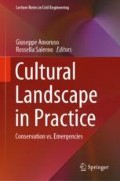Abstract
In this chapter, the effects of past interventions applied to historical city centers struck by a series of earthquakes over time are analyzed in terms of local and overall damage. Three villages in central Italy, Castelluccio di Norcia, Campi Alto di Norcia and Castelsantangelo sul Nera, containing overall about 150 buildings, are examined here. Classification of damage was based on the European Macroseismic Scale. The study provided vulnerability maps detailing the influence of interventions on buildings in historical city centers, which may contribute to better evaluation of damage scenario and maintenance plans.
Access this chapter
Tax calculation will be finalised at checkout
Purchases are for personal use only
Notes
- 1.
Acronym for ‘Italian Group of Defense against Earthquakes’.
- 2.
Acronym for ‘Level 1 Form for Post-Earthquake Damage and Usability Assessment and Emergency Countermeasures in Ordinary Buildings’.
References
Baggio C, Bernardini A, Colozza R (2000) Manuale per la compilazione della scheda di primo livello di rilevamento danno, pronto intervento e agibilità per edifici ordinari nell’emergenza post-sismica (AeDES). Servizio Sismico Nazionale-Gruppo Nazionale per la Difesa dai Terremoti, Roma (in Italian)
Benedetti D, Petrini L (1984) Sulla vulnerabilità degli edifici in muratura: proposta di un metodo di Valutazione. L’industria delle costruzioni 19(1):66–74 (in Italian)
Binda L, Cardani G, Saisi A, Valluzzi MR (2006) Vulnerability analysis of the historical buildings in seismic area by a multilevel approach. Asian J Civ Eng (Building and Housing), 7(4):343–357
Binda L, Cardani G, Saisi A, Valluzzi MR, Munari M, Modena C (2007) Multilevel approach to the vulnerability analysis of historic buildings in seismic areas—Part 1: detection of parameters for the vulnerability analysis through on site and laboratory investigations. Int. J Restor Build Monuments, 13(6):413–426
Binda L, Gambarotta L, Lagomarsino S, Modena C (1999) A multilevel approach to the damage assessment and seismic improvement of masonry buildings in Italy. In: Bernardini A (ed) Seismic damage to masonry buildings. Balkema, Rotterdam
Binda L, Saisi A (2005) Research on historic structures in seismic areas in Italy. Prog Struct Mat Eng 7:71–85
Borri A, Corradi M, Castori G, De Maria A (2015) A method for the analysis and classifica-tion of historic masonry. Bull Earthq Eng 13:1–19
Cardani G (2003) La vulnerabilità sismica dei centri storici: il caso di Campi Alto di Norcia. Linee guida per la diagnosi finalizzata alla scelta delle tecniche di intervento per la prevenzione dei danni. Ph.D. Thesis, Politecnico di Milano, Milano, Italy (in Italian)
Cifani G, Lemme A, Miozzi C, Russo G (1997) Aspetti metodologici. In: Repertorio dei meccanismi di danno, delle tecniche di intervento e dei relativi costi negli edifici in muratura sisma Marche 1997, Decreto del commissario delegato per gli interventi di protezione civile n. 28 del 10 aprile 2002, pp 233–268 (in Italian)
DPCM (2011) Approvazione del modello per il rilevamento dei danni, pronto intervento e agibilità per edifici ordinari nell’emergenza postsismica e del relativo manuale di compilazione. Gazzetta Ufficiale della Repubblica Italiana n. 113 del 17 maggio 2011 (Supplemento ordinario n. 123) (in Italian)
Ferrini M, Melozzi A, Pagliazzi A, Scarparolo S (2003) Rilevamento della vulnerabilità sismica degli edifici in muratura. Manuale per la compilazione della Scheda GDNT/CNR di II livello, Regione Toscana, http://www.regione.toscana.it/documents/10180/12262198/vsm_man.pdf/095d3648-191d-43aa-ae88-ad78cff79fb3. Last access June 2018. (in Italian)
Giuffrè A (1991) Letture sulla meccanica delle murature storiche. Kappa (ed) (in Italian)
GNDT-SSN (1994) Scheda di esposizione e vulnerabilità e di rilevamento danni di primo livello e secondo livello (muratura e cemento armato). Gruppo Nazionale per la Difesa dai Terremoti - Servizio Sismico Nazionale, Roma (in Italian)
Grunthal G. (1998) European Macrosismic Scale 1998. Conseil de l’ Europe, Cahiers du Centre Europeen de Geodynamique et de Seismologie, vol 15, Luxemburg
INGV http://www.ingv.it/it/. Last access June 2018
Modena C, Valluzzi MR, da Porto F, Casarin F (2011) Structural aspects of the conservation of historic masonry constructions in seismic areas: remedial measures and emergency actions. Int. J Architect Heritage 5(4–5):539–558. https://doi.org/10.1080/15583058.2011.569632
NTC (2008) Approvazione delle nuove norme tecniche per le costruzioni, Gazzetta Ufficiale della Repubblica Italiana, n. 29 del 4 febbraio 2008 (Supplemento ordinario n. 30) (in Italian)
Pinto AV, Taucer F (2007) Field Manual for post-earthquake damage and safety assessment and short-term countermeasures (AeDES), in JRC scientific and technical reports. Ispra, IT
Sbrogiò L, Cardani G, Valluzzi MR (2018) Damage survey of a historic town and comparison with past events after the 2016 central Italy earthquake. In: Proceeding of ECEE 16th European conference on earthquake engineering, Thessaloniki (Greece), 18–21 June 2018 (12 pp)
Valluzzi MR (2007) On the vulnerability of historical masonry structures: analysis and mitigation. Mater Struct 40:723–743. https://doi.org/10.1617/s11527-006-9188-7
Valluzzi MR (2016) Challenges and perspectives for the protection of masonry structures in historic centers: the role of innovative materials and techniques. Rilem Tech Lett 1:45–49. https://doi.org/10.21809/rilemtechlett.2016.10
Acknowledgements
Authors would like to thank D. Darù and M. Vettore for their contribution to on-site surveys. The research is framed within the DPC/ReLUIS 2014–2018 Italian project.
Author information
Authors and Affiliations
Corresponding author
Editor information
Editors and Affiliations
Rights and permissions
Copyright information
© 2019 Springer Nature Switzerland AG
About this chapter
Cite this chapter
Valluzzi, M.R., Sbrogiò, L. (2019). Vulnerability of Architectural Heritage in Seismic Areas: Constructive Aspects and Effect of Interventions. In: Amoruso, G., Salerno, R. (eds) Cultural Landscape in Practice. Lecture Notes in Civil Engineering , vol 26. Springer, Cham. https://doi.org/10.1007/978-3-030-11422-0_14
Download citation
DOI: https://doi.org/10.1007/978-3-030-11422-0_14
Published:
Publisher Name: Springer, Cham
Print ISBN: 978-3-030-11421-3
Online ISBN: 978-3-030-11422-0
eBook Packages: EngineeringEngineering (R0)

